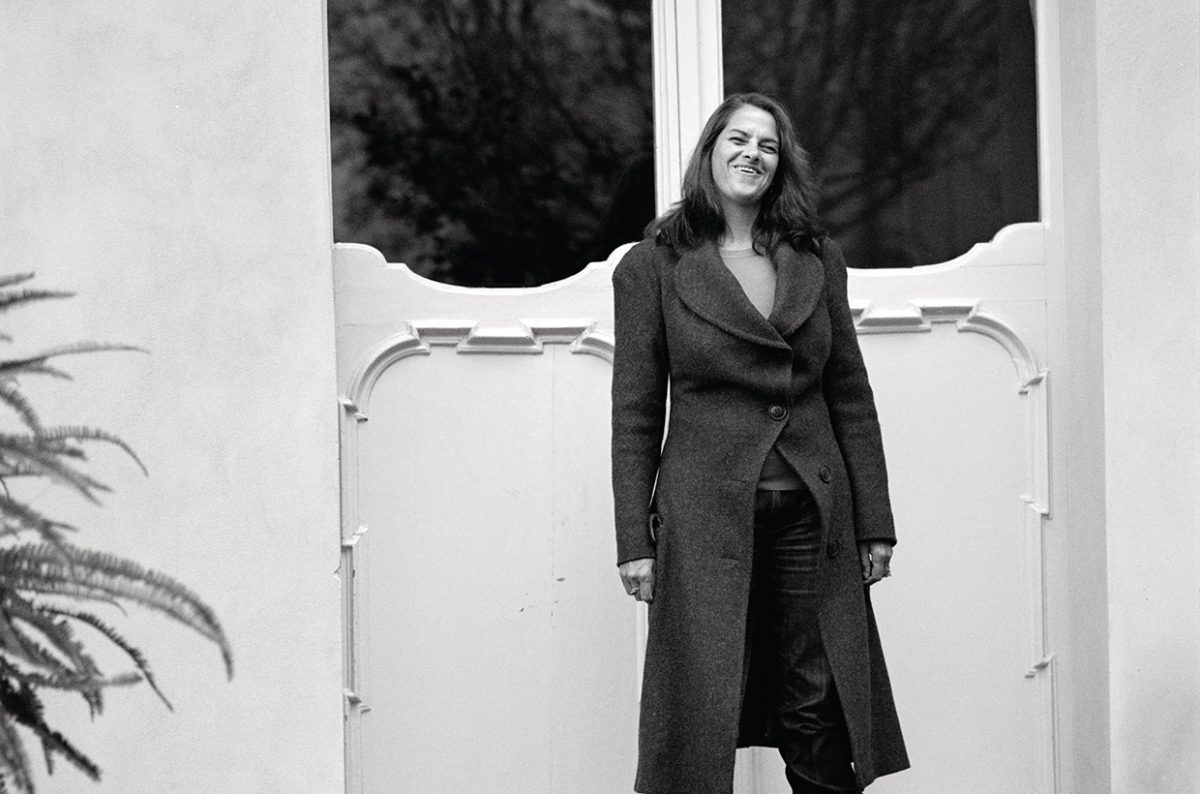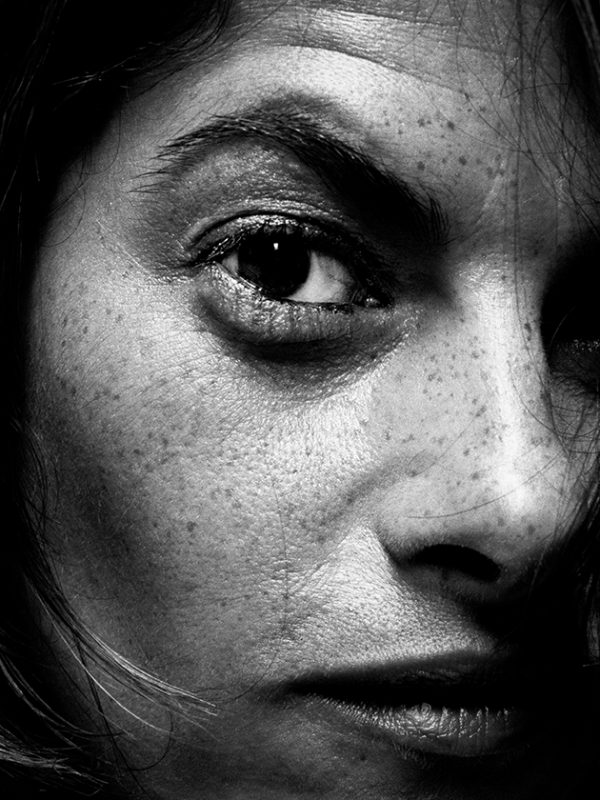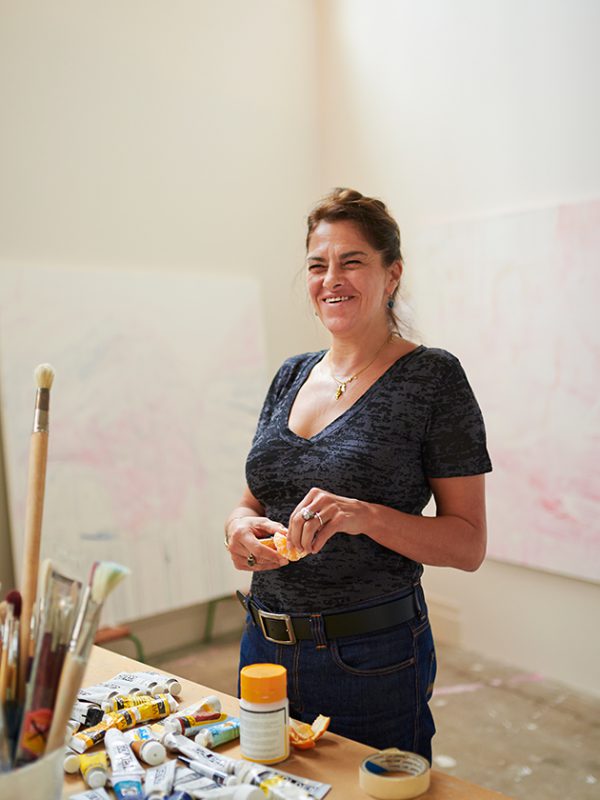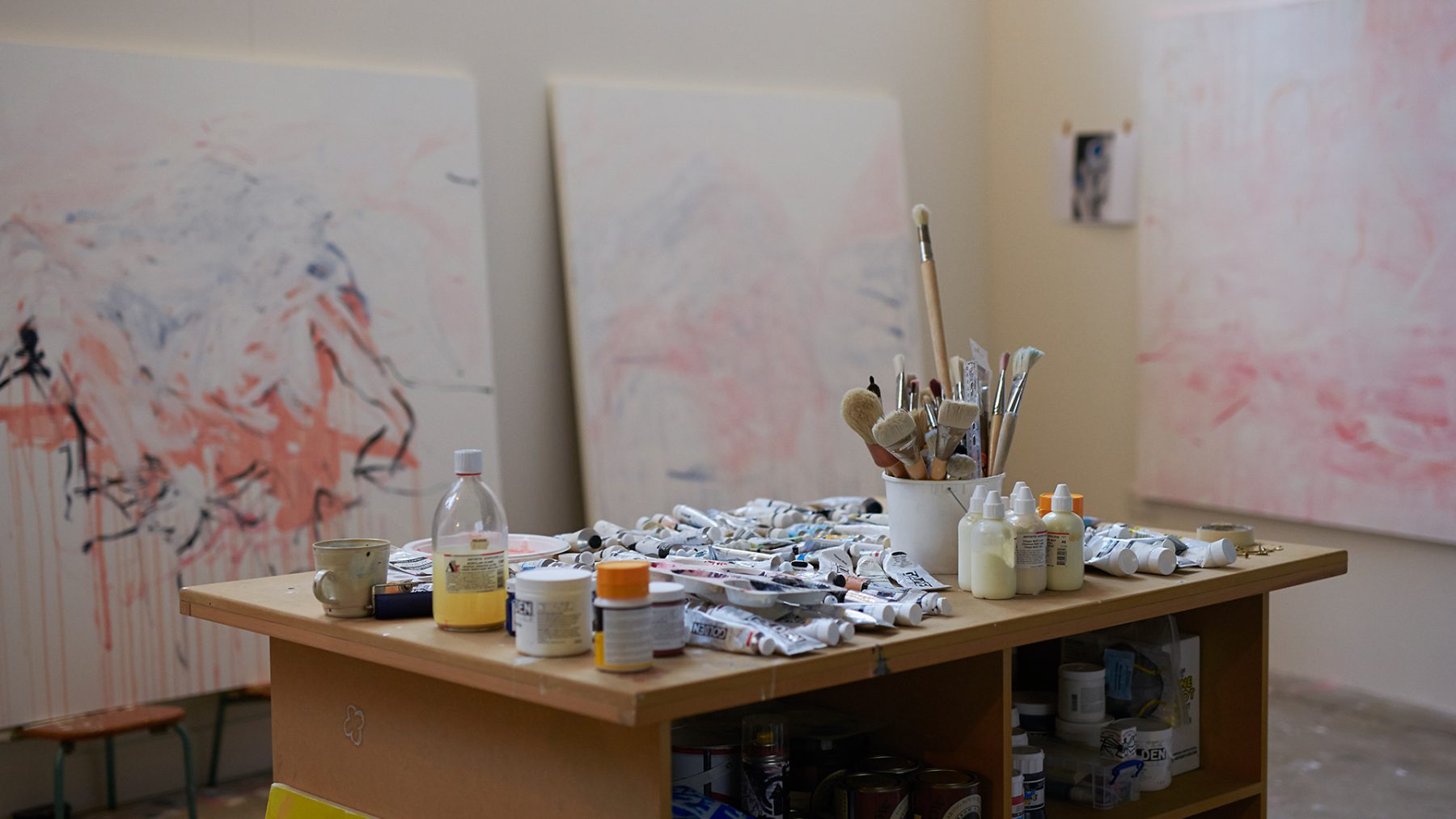Tracey Emin by Martin Tschechne | 5th March, 2021 | Personalities
Tracey Emin is well known as one of the most provocative artists of her time. Her recent cancer diagnosis has turned her last act into her happiest.
Tracey Emin was never one to keep her feelings to herself. She shocked the public with her display of overt, sometimes excessive sexuality, but that was precisely her intention. This way, she earned the freedom to present herself as a completely new, serious artist. At almost 60, she’s serene, reflective, self-assured, critical and independent enough to acknowledge the debt she owes to her role models in art history.
Perhaps Roberto was flattered – as were John, Frank, Chris and Suleman. Or was it alienating to them to discover their names up there with so many others? Some among them may have felt publicly exposed. What other woman would have compiled such a comprehensive ist of everyone she had ever slept with? And who else would have created such a large, brightly colored patchwork by embroidering their names on the inside of a tent? No one but Tracey Emin. Born in England and raised in Margate – by then an already deprived seaside town on Britain’s east coast – Tracey stepped onto London’s young art scene as an unknown from the sticks. A high school drop-out with a diploma in fashion design, she was attractive, though a little coarse, inquisitive, insecure and audacious. She was also severely traumatized by the two rapes she survived as a teenager and her first abortion at the age of 20.
The title of her tent installation: “Everyone I Have Ever Slept With 1963–1995” puts things in perspective. The work appears to be a swirling mixture of love, violence, affection, desperation and a longing for security. Specifying the exact time period was an essential component of the work, as it encompassed her entire life from birth up to that point. So the profusion of 102 names included that of her grandmother, who held her in her arms when she was an infant. Also among them, two unnamed fetuses. Language can be playful, but also brutally misleading.
The Tent was her breakthrough. The defiant artist had become a star. Attractive, a little bit coarse, inquisitive, insecure and audacious.
This was entirely intentional. The story of the tent tells us a great deal about who Tracey Emin was in 1995 and afterwards: her arrival in the metropolis of London, and soon thereafter, the award of a degree from the Royal College of Art. Yet for a long time, Emin remained something of a wallflower among the group of Young British Artists (YBA), whose members included Damien Hirst, Chris Ofili and Sarah Lucas. Artists who had caused their own scandals that had helped them establish themselves. When Carl Freedman, the curator of the South London Gallery, invited Emin to be part of the Minky Manky exhibition, he advised her to show “something big” after all the small-format pieces on paper that she had produced until then. The artist reacted angrily to the thinly veiled criticism. Something big? Something spectacular? Okay, then. That’s what he was going to get! The critics were thrilled and the piece was her breakthrough. Tracey Emin, the defiant artist, had suddenly become a star. The curator’s name was also stitched into the fabric of the tent.
That wasn’t the end of the story, though. Charles Saatchi offered to buy the tent for 12,000 British pounds, but Emin turned him down. Selling her work to an advertising mogul whose campaigns had helped Margaret Thatcher come to power? No way! The collector had to wait for the notorious piece to be put up for sale by a gallery owner. Saatchi paid 40,000 pounds and sent the work on tour with the Royal Academy’s spectacular Sensation exhibition, including to New York. Several years later a competitor allegedly offered to pay him 300,000 British pounds for it, but Saatchi declined. Some years after that, in 2004, the piece that had become an iconic work of art was destroyed in a fire.
The press lamented the irreplaceable loss. Saatchi offered Emin a cool million to reconstruct it, but she refused. Art has its limits. Where to begin the search for the scraps of fabric, each one imbued with its own history and meaning? Her artist colleague Stuart Semple swept up the ashes and sold them as objets trouvés, found objects, enclosed in plexiglas. That’s how the market works. The Young British Artists, whose works were by that time fetching exorbitant prices, had learned their lesson well. Only Tracey Emin reacted stoically, reminding people that wedding parties were being bombed in Iraq and that they should try to keep things in perspective.
By that time, she had already delivered a second iconic work, “My Bed” (1998), which was first exhibited in Tokyo and then went on a tour of museums and galleries around the world. The tent from three years earlier now felt like a juvenile provocation compared with the unmade bed with its dirty linen, complete with stains of blood and sperm and littered with dirty underwear, cigarette butts, used condoms, tampons, contraceptives and half empty vodka bottles. These were crazy, furious and frenetic times! At least until Saatchi started championing a new batch of artists, this time figurative painters, ranging from Martin Kippenberger to members of the New Leipzig School. The art market duly followed suit, as willingly as ever.
The wild, abused girl who often turned to violence herself is gone.
Emin was one of the very few artists to survive the vicissitudes of public opinion. In 2007, she was chosen to represent her country in the British pavilion at the Venice Biennale; and in 2011 appointed Professor of Drawing at the Royal Academy of Arts in London – one of only two female professors in the academy’s more than 250-year history, the other being Fiona Rae. There’s no question about it: Emin is among Britain’s most acclaimed artists. She refers to herself as a feminist, but objects to being called a feminist artist. Art is art, and the rest is the rest. Meanwhile, the Bed was sold at auction for 2.5 million pounds.
There has, after all, always been another Tracey Emin, who already stated several years ago that she no longer identified with the young woman she once was. She says she is now detached from her younger self and has entered a new phase of her life – artistically, morally and as a human being. It cannot be easy to distance yourself from an early work so immediate and intimate, but Emin has succeeded in doing so. The wild, abused girl who often turned to violence herself is gone. Life requires us to play new roles, some of them supported by the realization that after the wild times, more intensity can be found in being alone.
Emin says she has grown humbler, more compassionate, more honest with herself and generally more forgiving of weaknesses and doubt. Think of the aggressiveness required to stitch all those names of men, women and unborn children into the sides of a tent, take it to a museum and display it for all to see – did she really do that? Unthinkable, today.
Back then, she was lashing out, furious, offended and hurt. Very likely also driven by the ambition to emulate other artists, mostly men, who had caused a furor with sharks in formaldehyde or elephant dung paintings, which fetched huge sums. But after it had entered the pure, pristine art world, she once said in an interview, she never used her provocative bed again, adding bluntly that she hadn’t had sex in years, either. Hard liquor had never been her thing anyway and she had quit smoking. The monastery was calling, that’s how she described her life as early as 15 years ago.
So was it nothing but a fiction? A ruthless, immature attempt to reach the top of a market that paid handsomely for anything with Saatchi’s name on it, or bearing the YBA trademark? Tracey Emin avoids thinking about her more embarrassing memories. After all, she can point to a solid foundation – apart from a few aberrations – on which her biography as an artist is built.
She has also nurtured elective affinities with kindred spirits over many years. Among these are Viennese artist Egon Schiele with his unflinching images of the human body, Francis Bacon, the expressive painter of the human form and the American sculptor Louise Bourgeois, whose struggle to plumb the depths of her own traumas Emin witnessed at the time. Add to that, William Turner, the great, pioneering Romantic painter.
Last November, the Royal Academy gave her the opportunity to celebrate an artistic encounter she had been preparing for a very long time. A double exhibition entitled “The Loneliness of the Soul,” it featured works by Norwegian artist Edvard Munch alongside Emin’s own art, and was originally supposed to open in Oslo. In addition to showing new paintings of her own, many of them large-format works, she had planned to take an over-sized bronze nude, a kneeling, seven-meter tall “mother” to Norway in order to celebrate the opening of the brand-new, gleaming Munch Museet that had been built on the waterfront by Oslo architects Snøhetta.
The artist has admitted that as a girl, she had been madly in love with the super-sensitive painter who feared women his entire life, clarifying that she was physically attracted to him, too. But then the corona pandemic interrupted her travel plans. For now only in her own country and through the end of February, she will be demonstrating how the shy Norwegian’s work influenced her in coming to terms with the sensuality of painting. She will also be talking about surrendering herself to materials and to chance, about the physicality of the act of painting, and about allowing yourself to drift, to float. And she wouldn’t be Tracey Emin if she didn’t finish by saying that this kind of painting is, well, very much like sex.
Last year, Emin tells us, a sensuous but disturbing blood-red and black painting emanated from her, seemingly forcing its way out, unplanned and unintended. Shortly afterwards, doctors discovered a tumor. Last summer, twelve surgeons spent six hours removing almost all the organs in her lower abdomen: her uterus, her bladder, her ovaries, parts of her colon and parts of her vagina. The artist has never been shy about sharing intimate details with the public. The tumor had the exact same shape as the amorphous work her hand and brush had forced onto the canvas.
So there is a good chance this article will soon be read as an obituary. However, Emin says she is happy now, very happy, actually. Her art fulfills her, and as far as she is concerned, things could very well continue as they are. She had given her life a new direction even before receiving her diagnosis, and has now become even more introspective. Emin has also moved back to her hometown of Margate, and the unparalleled light on its coastline. One day, her current home will house her archive and her museum.







